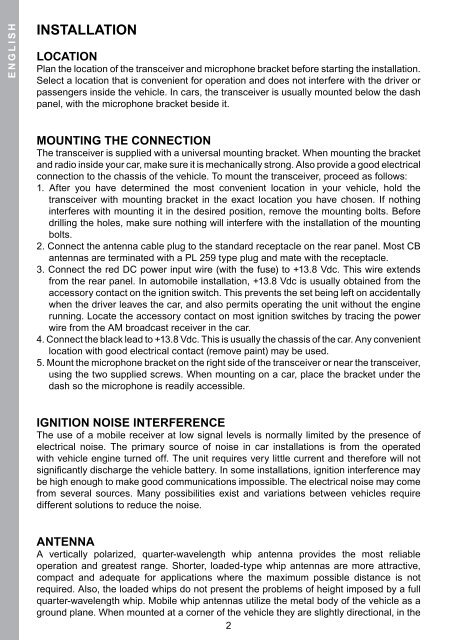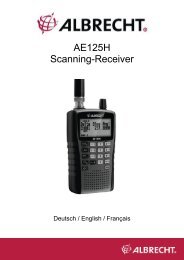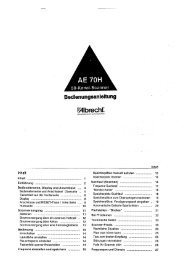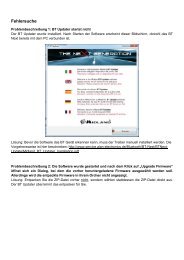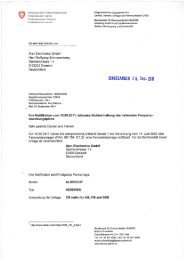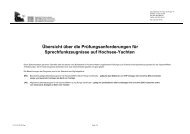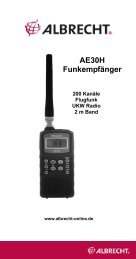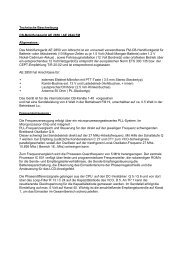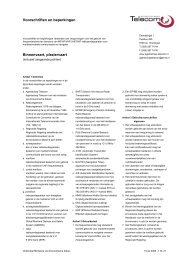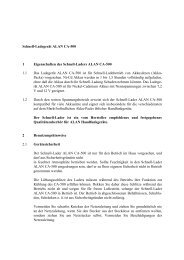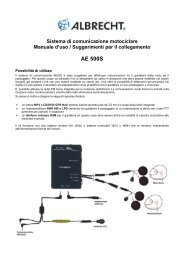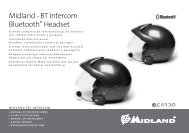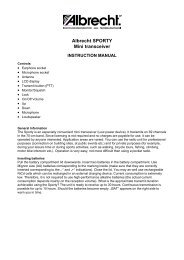ALAN 8001S EURO
ALAN 8001S EURO
ALAN 8001S EURO
You also want an ePaper? Increase the reach of your titles
YUMPU automatically turns print PDFs into web optimized ePapers that Google loves.
E N G L I S H<br />
INSTALLATION<br />
LOCATION<br />
Plan the location of the transceiver and microphone bracket before starting the installation.<br />
Select a location that is convenient for operation and does not interfere with the driver or<br />
passengers inside the vehicle. In cars, the transceiver is usually mounted below the dash<br />
panel, with the microphone bracket beside it.<br />
MOUNTING THE CONNECTION<br />
The transceiver is supplied with a universal mounting bracket. When mounting the bracket<br />
and radio inside your car, make sure it is mechanically strong. Also provide a good electrical<br />
connection to the chassis of the vehicle. To mount the transceiver, proceed as follows:<br />
. After you have determined the most convenient location in your vehicle, hold the<br />
transceiver with mounting bracket in the exact location you have chosen. If nothing<br />
interferes with mounting it in the desired position, remove the mounting bolts. Before<br />
drilling the holes, make sure nothing will interfere with the installation of the mounting<br />
bolts.<br />
2. Connect the antenna cable plug to the standard receptacle on the rear panel. Most CB<br />
antennas are terminated with a PL 259 type plug and mate with the receptacle.<br />
3. Connect the red DC power input wire (with the fuse) to + 3.8 Vdc. This wire extends<br />
from the rear panel. In automobile installation, + 3.8 Vdc is usually obtained from the<br />
accessory contact on the ignition switch. This prevents the set being left on accidentally<br />
when the driver leaves the car, and also permits operating the unit without the engine<br />
running. Locate the accessory contact on most ignition switches by tracing the power<br />
wire from the AM broadcast receiver in the car.<br />
4. Connect the black lead to + 3.8 Vdc. This is usually the chassis of the car. Any convenient<br />
location with good electrical contact (remove paint) may be used.<br />
5. Mount the microphone bracket on the right side of the transceiver or near the transceiver,<br />
using the two supplied screws. When mounting on a car, place the bracket under the<br />
dash so the microphone is readily accessible.<br />
IGNITION NOISE INTERFERENCE<br />
The use of a mobile receiver at low signal levels is normally limited by the presence of<br />
electrical noise. The primary source of noise in car installations is from the operated<br />
with vehicle engine turned off. The unit requires very little current and therefore will not<br />
significantly discharge the vehicle battery. In some installations, ignition interference may<br />
be high enough to make good communications impossible. The electrical noise may come<br />
from several sources. Many possibilities exist and variations between vehicles require<br />
different solutions to reduce the noise.<br />
ANTENNA<br />
A vertically polarized, quarter-wavelength whip antenna provides the most reliable<br />
operation and greatest range. Shorter, loaded-type whip antennas are more attractive,<br />
compact and adequate for applications where the maximum possible distance is not<br />
required. Also, the loaded whips do not present the problems of height imposed by a full<br />
quarter-wavelength whip. Mobile whip antennas utilize the metal body of the vehicle as a<br />
ground plane. When mounted at a corner of the vehicle they are slightly directional, in the<br />
2


